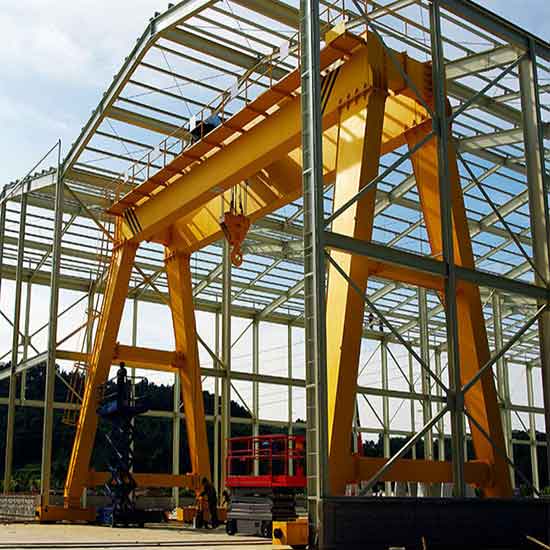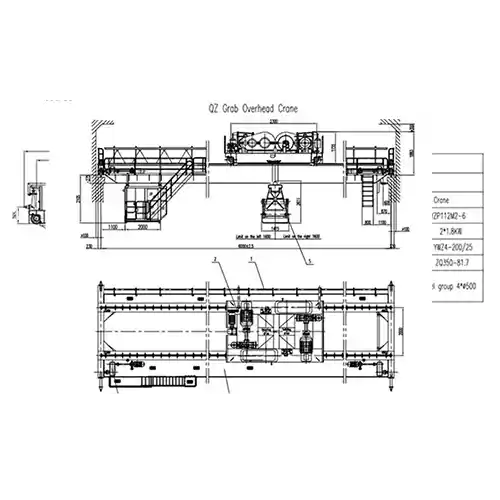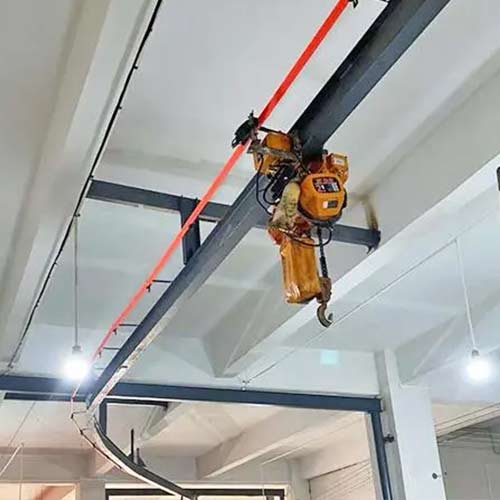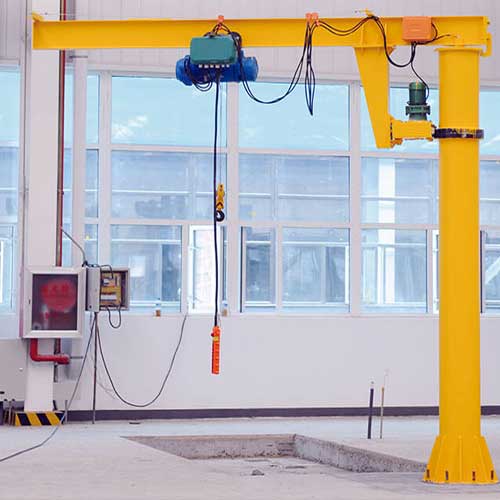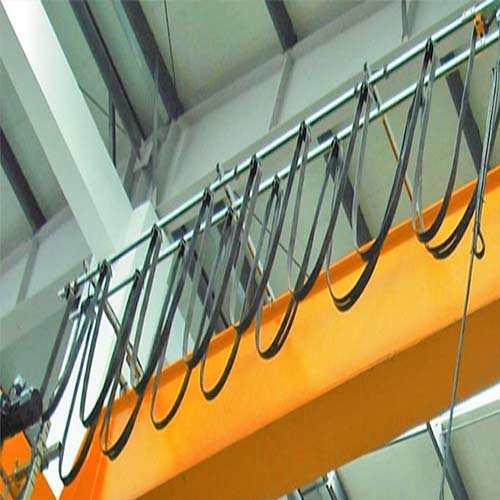Electric Gantry Crane & Electric Gantry Goliath Crane 5 Ton -100 Ton
Electric gantry crane for sale. Electric gantry cranes & goliath crane for sale, 5 ton, 10 ton, 20 ton, 30 ton, 40 ton, 50 ton to 100 ton tailored for you.
Category: Overhead Crane for Your Use
Your Trusted Electric Overhead Crane Manufacturer & Supplier
Electric Gantry Crane & Electric Gantry Goliath Crane 5 Ton -100 Ton
Electric gantry crane for sale. Electric gantry cranes & goliath crane for sale, 5 ton, 10 ton, 20 ton, 30 ton, 40 ton, 50 ton to 100 ton tailored for you.
Introduction to Electric Gantry Cranes
An electric gantry crane is a type of material handling equipment that features a bridge supported by legs (gantry) and moves on rails or wheels. It is designed for lifting and moving heavy loads horizontally within a defined area.
Gantry cranes are widely used in various industries, including manufacturing, construction, ports, warehouses, and shipyards, for their versatility and efficiency in material handling tasks.
Types of Gantry Cranes:

Rail-mounted Gantry Crane (RMG Crane):
RMG cranes move on rails mounted to the ground, providing stable and precise movements. They are commonly used in ports, intermodal yards, and rail terminals for container handling.

Rubber-tired Gantry Crane (RTG Crane):
RTG cranes are equipped with rubber tires, allowing them to move on paved surfaces without the need for rails. They are commonly used in container terminals and ports for handling shipping containers.
Importance and Applications in Material Handling:
Electric gantry cranes play a crucial role in modern material handling operations due to their numerous benefits and applications.
Key applications include:
- 1. Ports and Container Terminals: Gantry cranes are essential for loading and unloading shipping containers from vessels and trucks, ensuring efficient port operations.
- 2. Shipbuilding and Repair Yards: Gantry cranes assist in lifting and positioning ship components during construction, maintenance, and repair tasks.
- 3. Construction Sites: Gantry cranes are used in construction projects to handle heavy materials, equipment, and prefabricated components.
- 4. Warehouses and Distribution Centers: Gantry cranes help in organizing and moving goods within warehouses, improving logistics and storage efficiency.
- 5. Manufacturing Facilities: Gantry cranes aid in the assembly, production, and transportation of large and heavy products in manufacturing industries.
- 6. Railroad and Intermodal Yards: Gantry cranes are employed for efficient handling of cargo containers between trains and trucks.
Their ability to lift heavy loads and transport them horizontally makes electric gantry cranes indispensable in a wide range of industries, contributing to streamlined operations and increased productivity.
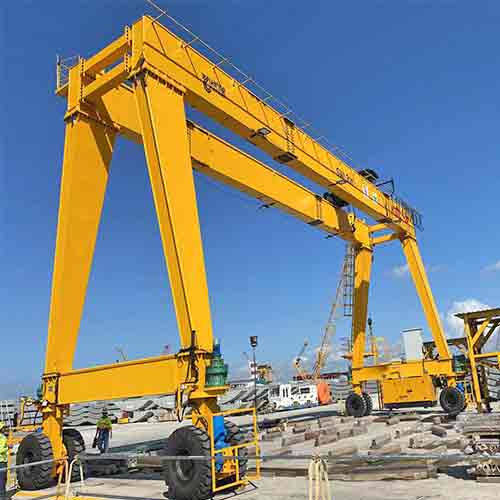
Electric Rubber-tired Gantry Crane (Electric RTG Crane):
Description and Working Principle: The electric rubber-tired gantry crane, commonly known as the electric RTG crane, is equipped with rubber tires and wheels, allowing it to move independently without fixed rails. Electric RTG cranes are designed with a cabin for the operator, situated at one end of the gantry, providing an unobstructed view of the loading and unloading operations.
Advantages:
- High Mobility: Electric RTG cranes can maneuver freely without the need for fixed tracks, making them highly mobile and flexible in congested yards and terminals.
- Quick Turnaround: Their mobility enables efficient handling of containers and cargo, leading to faster loading and unloading operations in ports and container terminals.
- Cost-effectiveness: Electric RTG cranes eliminate the need for expensive rail infrastructure, making them a cost-effective solution for container handling.
Applications:
- Container Terminals: Electric RTG cranes are extensively used in container terminals for stacking and transferring shipping containers between trucks and storage yards.
- Intermodal Yards: Electric RTG cranes handle containers between trains and trucks in intermodal facilities.
- Port Operations: Electric RTG cranes contribute to efficient port operations, facilitating the movement of cargo between vessels and land transportation.
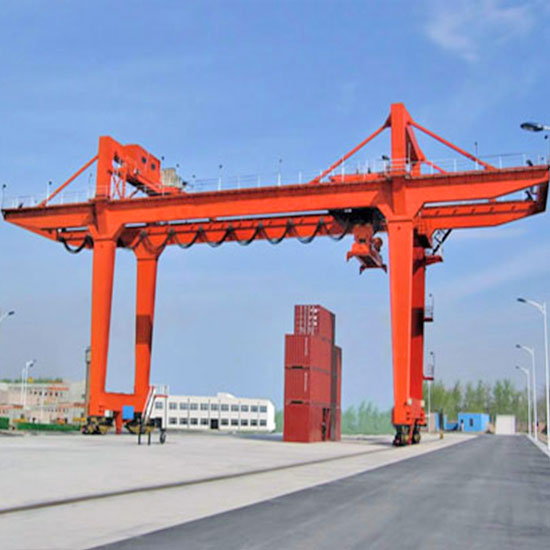
Rail mounted electric gantry cranes (Electric RMG Gantry Crane )
Description and Working Principle: Rail travelling electric gantry cranes, also known as rail-mounted gantry cranes (RMG cranes), operate on fixed rails that guide their movement along the length of the gantry. These cranes are equipped with a trolley system featuring hoists, allowing for vertical lifting and horizontal movement of cargo along the gantry.
Advantages:
- Precise Movements: Rail travelling electric gantry cranes move on fixed rails, ensuring precise and repeatable positioning of loads.
- High Load Capacity: RMG cranes are designed for heavy-duty applications, capable of handling large and heavy containers and cargo.
- Stability: The rail-mounted design provides stability, making RMG cranes suitable for use in high-wind environments.
Applications:
- Container Yards: Rail travelling electric gantry cranes are used in container terminals and yards for efficient stacking and handling of shipping containers.
- Rail Terminals: These cranes are employed in rail terminals for loading and unloading cargo containers from trains.
- Intermodal Facilities: Rail travelling electric gantry cranes facilitate the transfer of containers between different modes of transportation.
- Electric gantry cranes, including electric RTG cranes and rail travelling electric gantry cranes, offer essential advantages such as mobility, versatility, and high load capacity. These features make them indispensable in material handling operations, particularly in container terminals, ports, and intermodal facilities.
Portable Gantry Crane:
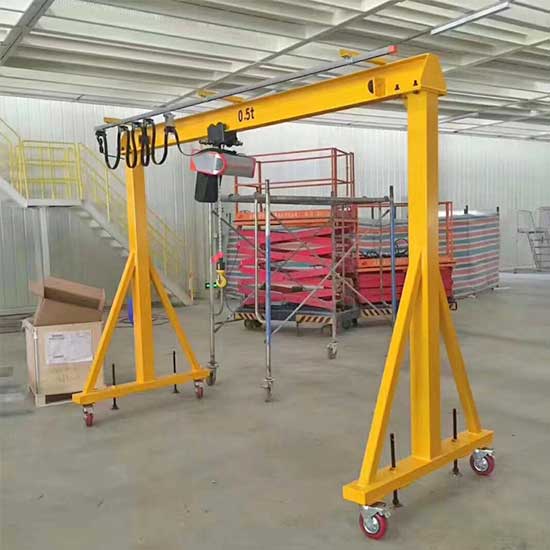
Fixed Height Portable Gantry Crane: Description: Fixed height portable gantry cranes are designed with a fixed vertical clearance between the legs. They are suitable for consistent lifting tasks within a specific height range.
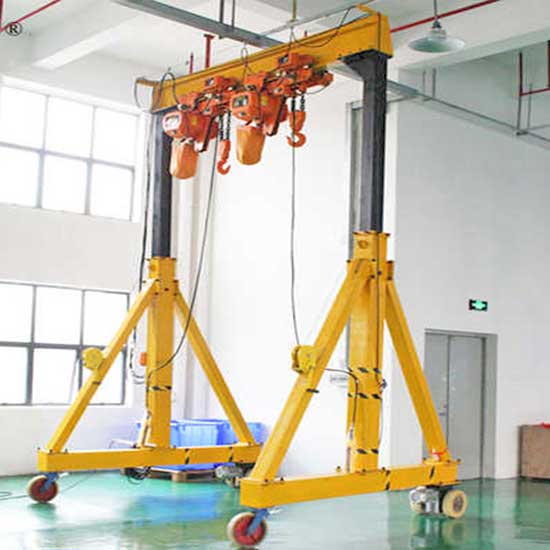
Adjustable Height Portable Gantry Crane: Description: Adjustable height portable gantry cranes feature height-adjustable legs, allowing operators to set different lifting heights based on their needs.
Advantages:
- Portability: Portable gantry cranes are easy to assemble, disassemble, and move to different locations, providing flexibility in various work environments.
- Quick Setup: Their modular design allows for quick assembly and disassembly without the need for permanent installation, making them ideal for temporary lifting needs.
Applications:
- Construction Sites: Portable gantry cranes are commonly used in construction sites for lifting construction materials and equipment.
- Maintenance and Repair: These cranes are suitable for maintenance and repair tasks in industrial facilities and workshops.
- Warehouse and Workshop: Portable gantry cranes aid in material handling within warehouses and workshops with changing lifting requirements.
- Portable gantry cranes offer versatility and convenience, making them an excellent choice for applications that require mobility and adaptability in lifting operations.
Components and Structure of Electric Gantry Cranes
Gantry Structure:
- The gantry structure forms the main framework of the electric gantry crane. It consists of sturdy steel beams that support the bridge and the hoist-trolley system.
- The gantry structure is designed to provide stability and rigidity to the crane, allowing it to withstand heavy loads and dynamic forces during lifting and movement.
- Gantry cranes come in different configurations, including single girder and double girder designs, depending on the lifting capacity and application requirements.
Hoist and Trolley System:
- The hoist and trolley system is a critical component responsible for lifting and moving the load horizontally along the gantry.
- The hoist comprises an electric motor, gearbox, and a drum or chain system that winds the wire rope or chain to lift the load.
- The trolley, equipped with wheels or rollers, runs along the bridge, enabling the horizontal movement of the load across the span of the gantry crane.
- Electric gantry cranes may use wire rope hoists or electric chain hoists, depending on the specific application and load capacity.
Power Supply System:
- The power supply system provides electricity to drive the various motors and controls of the electric gantry crane.
- Depending on the crane's design and application, the power supply can be either single-phase or three-phase, depending on the voltage and frequency requirements.
- The power supply is connected to the electric motors of the hoist, trolley, and other mechanisms to enable their smooth and efficient operation.
Control Mechanism:
- The control mechanism of an electric gantry crane is responsible for managing the crane's movements and functions.
- Modern gantry cranes are equipped with advanced control systems that may include variable frequency drives (VFDs) for smooth acceleration and deceleration, precise positioning, and speed control.
- The operator's cabin or control panel is equipped with controls and instruments that allow the operator to operate the crane safely and efficiently.
- Some electric gantry cranes also feature remote control systems that enable operators to control the crane's movements from a distance, enhancing safety and productivity.
Electric gantry cranes are designed with robust components and structures to ensure safe and reliable material handling operations. The gantry structure provides the necessary support and stability, while the hoist and trolley system enable efficient lifting and movement of heavy loads. The power supply system and control mechanism work together to power and manage the crane's operations, making it a valuable asset in various industries and material handling applications.
Features and Benefits of Electric Gantry Cranes
Versatility and Flexibility:
- Electric gantry cranes are highly versatile and can be used for a wide range of material handling tasks.
- They are suitable for lifting and moving various loads, including containers, heavy machinery, construction materials, and other bulky items.
- Gantry cranes can adapt to different load sizes and shapes, making them flexible for diverse applications across various industries.
Easy Mobility and Portability:
- One of the significant advantages of electric gantry cranes is their mobility and portability.
- Rubber-tired gantry cranes (RTG cranes) can move independently without fixed rails, allowing easy relocation and positioning in different areas of the facility.
- Portable gantry cranes can be assembled, disassembled, and moved to different locations, making them ideal for temporary lifting needs in workshops and construction sites.
Suitable for Outdoor and Indoor Applications:
- Electric gantry cranes are designed to operate effectively both indoors and outdoors.
- Rail-mounted gantry cranes (RMG cranes) are commonly used in outdoor environments, such as container terminals and shipyards, where containers and cargo need to be handled efficiently.
- Electric gantry cranes with weather-resistant features can withstand outdoor conditions and provide reliable performance in various weather conditions.
Enhanced Load Handling Capacity:
- Electric gantry cranes are engineered for heavy-duty applications, offering enhanced load handling capacities.
- RMG cranes are capable of handling large and heavy containers, while RTG cranes can efficiently stack and move shipping containers in container terminals and ports.
- The adjustable height and capacity of portable gantry cranes cater to diverse lifting needs in warehouses, workshops, and construction sites.
- The enhanced load handling capacity of electric gantry cranes translates to improved productivity, reduced manual effort, and faster material handling operations.
Electric gantry cranes offer numerous features and benefits that enhance material handling efficiency in various industries. Their versatility allows them to handle different types of loads and adapt to changing lifting requirements. Additionally, their mobility and portability provide flexibility in arranging the material handling process within the facility. Whether used in outdoor environments or indoors, electric gantry cranes contribute to streamlined operations, increased productivity, and improved safety standards.
Applications of Electric Gantry Cranes
Ports and Container Terminals:
- Electric gantry cranes play a vital role in container terminals and ports for efficient handling of shipping containers.
- Rail-mounted gantry cranes (RMG cranes) are commonly used for stacking and retrieving containers in container yards, facilitating the movement of cargo between vessels and land transportation.
- Rubber-tired gantry cranes (RTG cranes) are deployed for the handling of containers in container terminals, offering high mobility and quick turnaround times.
Shipbuilding and Repair Yards:
- Electric gantry cranes are essential in shipbuilding and repair yards, supporting the construction and maintenance of ships.
- These cranes assist in lifting and positioning ship components, heavy machinery, and equipment during the shipbuilding process.
- Ship repair yards use gantry cranes to lift ships out of the water for inspection, maintenance, and repairs.
Construction Sites:
- Construction sites employ electric gantry cranes for material handling and lifting tasks.
- Gantry cranes assist in moving construction materials, equipment, and prefabricated components at the construction site.
- Their mobility and portability make them suitable for use in various construction projects, both for vertical construction and horizontal transportation.
Warehouses and Distribution Centers:
- Electric gantry cranes are utilized in warehouses and distribution centers for efficient material handling operations.
- Gantry cranes aid in loading and unloading goods from trucks, organizing and stacking inventory, and optimizing storage space.
- Portable gantry cranes are often used in warehouses for flexible material handling within limited spaces.
Manufacturing Facilities:
- Electric gantry cranes are indispensable in manufacturing facilities for various material handling tasks.
- They assist in the assembly, production, and transportation of heavy machinery, parts, and finished products along the manufacturing line.
- Gantry cranes improve workflow efficiency, reduce manual labor, and enhance safety in manufacturing processes.
Electric gantry cranes are widely employed in these applications due to their versatility, load-handling capacity, and ability to operate in diverse environments. They contribute to streamlined material handling operations, increased productivity, and reduced operational costs across various industries.
Safety Considerations for Electric Gantry Cranes
Overload Protection:
- Overload protection is a critical safety feature in electric gantry cranes that prevents the crane from lifting loads beyond its rated capacity.
- Load cells or weight sensors are integrated into the hoist or trolley system to continuously monitor the load being lifted.
- When the load approaches or exceeds the safe working load limit, the overload protection system triggers an alarm or stops the lifting operation, ensuring safe lifting practices.
Limit Switches and Sensors:
- Limit switches and sensors are installed at specific points on the gantry crane to prevent over-travel or collisions.
- These safety devices trigger automatic stops when the crane reaches the end of its permitted travel range or encounters any obstacles.
- Limit switches and sensors enhance safety by preventing accidental collisions and protecting the crane and surrounding structures.
Emergency Stop Mechanism:
- Electric gantry cranes are equipped with emergency stop buttons or switches to halt all crane movements immediately in case of an emergency.
- The emergency stop mechanism is readily accessible to the crane operator and other personnel to prevent accidents or potential hazards.
- Activating the emergency stop instantly cuts power to all crane functions, ensuring quick response and protecting personnel and assets.
Operator Training and Safety Guidelines:
- Proper operator training is essential for safe and efficient operation of electric gantry cranes.
- Operators should undergo comprehensive training on crane operation, safety procedures, and the use of control systems.
- Safety guidelines should be strictly followed, including wearing personal protective equipment (PPE) and ensuring safe clearance when lifting or moving loads.
- Regular safety training and refresher courses help operators stay updated on safety protocols and best practices.
Complying with safety standards, conducting regular inspections, and addressing maintenance issues promptly are crucial to ensure the safe operation of electric gantry cranes. Adhering to safety guidelines not only protects personnel and equipment but also enhances productivity and minimizes the risk of accidents or downtime.
Maintenance and Inspection of Electric Gantry Cranes
Regular Maintenance Practices:
- Regular maintenance is crucial for ensuring the safe and reliable operation of electric gantry cranes.
- Maintenance practices should be performed according to the manufacturer's recommendations and industry standards.
- Daily, weekly, monthly, and yearly maintenance routines should be established to keep the crane in optimal condition.
Some common regular maintenance practices include:
- 1. Visual Inspections: Regularly inspecting the crane for signs of wear, damage, or loose components.
- 2. Cleaning: Keeping the crane clean from dust, debris, and contaminants that may affect its performance.
- 3. Tightening: Checking and tightening all nuts, bolts, and fasteners to prevent loosening during operation.
- 4. Greasing: Applying grease to lubrication points to reduce friction and wear on moving parts.
Inspection Checklist:
- An inspection checklist provides a systematic approach to evaluate the condition of the electric gantry crane.
- The checklist should cover various components, structural elements, electrical systems, and safety devices.
The inspection checklist may include:
- 1. Hoist and Trolley: Check for proper wire rope or chain alignment, condition of hooks, and functional brakes.
- 2. Gantry Structure: Inspect the gantry structure for signs of corrosion, cracks, or structural deformities.
- 3. Electrical Systems: Verify the functionality of limit switches, overload protection, emergency stop, and control mechanisms.
- 4. Power Supply System: Ensure that the power supply and electrical connections are secure and free from damage.
- 5. Safety Devices: Test the operation of limit switches, sensors, and emergency stop mechanisms.
Lubrication and Component Care:
- Proper lubrication is essential for reducing friction, preventing wear, and extending the lifespan of moving parts in the gantry crane.
- Regularly lubricate hoist drums, sheaves, bearings, and other critical components as recommended by the manufacturer.
Component care includes:
- 1. Wire Rope and Chain Maintenance: Inspect wire ropes and chains for signs of wear, corrosion, or kinks. Replace them if necessary.
- 2. Motor and Gearbox: Check and maintain electric motors and gearboxes to ensure efficient performance.
- 3. Brakes: Inspect and adjust brakes to ensure they are in good working condition.
Maintenance and component care should be performed by qualified technicians who are trained in crane maintenance and repair.
A well-planned maintenance and inspection program helps identify potential issues before they escalate into major problems. Regular care and attention to the crane's components and systems ensure safe and efficient operations, prolong the crane's lifespan, and reduce the risk of unplanned downtime.
Factors to Consider when Selecting an Electric Gantry Crane
Lifting Capacity and Span:
- Determine the maximum weight of the loads that the electric gantry crane will be required to lift. Consider both the average load weight and any occasional heavier loads.
- Evaluate the span or distance between the legs of the gantry crane. The span should be wide enough to accommodate the loads and provide sufficient stability during lifting operations.
Workspace and Environment:
- Assess the available workspace and layout where the electric gantry crane will operate. Consider factors such as the height and width of the space, potential obstacles, and any height restrictions.
- For outdoor applications, consider weather conditions, wind exposure, and the need for weather-resistant features to protect the crane from the elements.
Mobility and Portability Requirements:
- Determine if the electric gantry crane needs to be movable and portable. For some applications, such as construction sites or temporary projects, portability is essential for easy relocation.
- For fixed locations, consider a rail-mounted gantry crane (RMG crane) if mobility is not required.
Power Supply and Electrical Requirements:
- Ensure that the facility has the necessary power supply to meet the electrical requirements of the electric gantry crane.
- Evaluate whether single-phase or three-phase power is available, as this will determine the crane's motor configuration and performance.
- Consider any specific voltage and frequency requirements to ensure compatibility with the power supply.
Safety Features and Compliance:
- Verify that the electric gantry crane meets all relevant safety standards and regulations.
- Ensure the crane is equipped with essential safety features, such as overload protection, limit switches, emergency stop mechanisms, and proper lighting for clear visibility.
Application-Specific Features:
- Depending on the specific application, consider additional features or accessories that may be required. For example, if the crane will handle containers, consider container spreaders or lifting attachments.
- For hazardous environments, ensure that the gantry crane is equipped with appropriate safety features and meets the necessary certifications.
Budget and Total Cost of Ownership:
- Consider the initial investment and the long-term cost of owning and maintaining the electric gantry crane.
- Factor in maintenance costs, spare parts availability, and the crane's expected lifespan to evaluate the total cost of ownership.
Manufacturer and Support:
- Choose a reputable manufacturer with a track record of producing high-quality electric gantry cranes.
- Ensure that the manufacturer provides comprehensive customer support, including installation, training, maintenance, and spare parts availability.
By carefully considering these factors, you can select the most suitable electric gantry crane that meets your specific lifting requirements, workspace constraints, and operational needs. A well-informed decision ensures that the chosen crane enhances efficiency, productivity, and safety in your material handling operations.
Customization Options for Electric Gantry Cranes
Size and Capacity:
- Electric gantry cranes can be customized to meet specific size and lifting capacity requirements.
- Manufacturers can design and build gantry cranes with various spans, heights, and load capacities to suit different applications and workspaces.
- Customization allows the crane to be precisely tailored to handle the intended loads and fit within the available space.
Control System and Automation:
- Electric gantry cranes can be equipped with various control systems and automation features to optimize their operation.
- Advanced control systems, such as variable frequency drives (VFDs), allow for smooth and precise crane movements, improving load positioning and minimizing sway.
- Automation options may include programmable logic controllers (PLCs) and remote control capabilities, enabling automated functions and remote operation for increased efficiency.
Additional Safety Features:
- While electric gantry cranes come with essential safety features, customization allows for the incorporation of additional safety measures.
- Customers can request specialized safety devices, such as anti-collision systems, area sensors, or cameras for enhanced visibility and accident prevention.
- Specific safety features can be tailored to address the unique safety concerns of the application or environment.
Integration with Existing Infrastructure:
- Custom electric gantry cranes can be designed to seamlessly integrate with existing infrastructure and equipment.
- This includes matching the crane's dimensions to fit within available workspaces or aligning the control interfaces with existing control systems.
- Integration ensures a smooth transition and efficient operation within the existing material handling setup.
Specialized Attachments and Accessories:
- Customers can choose from a range of specialized lifting attachments and accessories to suit their specific application needs.
- Options may include spreader bars, hooks, magnets, grabs, or custom-designed lifting tools.
- These attachments enable the gantry crane to handle various types of loads and materials efficiently.
Weather-Resistant and Outdoor Use:
- For outdoor applications, customization can include weather-resistant features to protect the crane from adverse weather conditions.
- Outdoor gantry cranes may be equipped with special coatings, seals, or materials to prevent corrosion and maintain reliable performance in outdoor environments.
Customization options allow customers to tailor electric gantry cranes to their exact requirements, ensuring optimal performance, safety, and efficiency. Working closely with experienced crane manufacturers, customers can design a bespoke solution that maximizes productivity and meets the unique demands of their material handling operations.
Comparing Electric Gantry Cranes with Other Types of Cranes
Advantages over Electric Overhead Cranes:
- 1. Mobility: Electric gantry cranes offer greater mobility compared to electric overhead cranes. Gantry cranes can move along rails (RMG cranes) or have rubber tires (RTG cranes), providing flexibility in positioning and repositioning the crane as needed.
- 2. Portability: Portable gantry cranes provide an advantage over fixed electric overhead cranes, as they can be disassembled and moved to different locations, making them suitable for temporary or changing work environments.
- 3. Cost-effectiveness: Gantry cranes, particularly rubber-tired gantry cranes, can be more cost-effective to set up and maintain since they don't require fixed runway systems like electric overhead cranes.
- 4. Outdoor Use: Gantry cranes, especially rubber-tired gantry cranes, are well-suited for outdoor use in container yards, shipyards, and construction sites, while electric overhead cranes are typically designed for indoor use in warehouses and manufacturing facilities.
Differences from Mobile and Tower Cranes:
- 1. Portability: Both mobile and tower cranes are designed for high mobility and portability, being mounted on wheeled vehicles or fixed to the ground respectively. In contrast, electric gantry cranes are stationary and move along rails or have rubber tires for short-distance mobility.
- 2. Height and Reach: Tower cranes are known for their impressive height and long reach, making them suitable for high-rise construction projects. Mobile cranes offer good reach and mobility for various construction and lifting tasks. Gantry cranes have limited height and reach in comparison, but they excel in material handling within a specific workspace.
- 3. Stability: Tower cranes have excellent stability due to their fixed structure, which allows them to lift extremely heavy loads at great heights. Mobile cranes achieve stability through outriggers when stationary. Gantry cranes have a stable structure with wide legs, providing stability for heavy lifting and movement along the rails or on rubber tires.
- 4. Typical Applications: Mobile cranes are often used in construction sites and infrastructure projects. Tower cranes are common in high-rise construction. Electric gantry cranes find applications in container terminals, shipyards, manufacturing, warehouses, and other material handling operations within confined spaces.
Electric gantry cranes offer unique advantages in terms of mobility, cost-effectiveness, and suitability for outdoor use. While they may not match the height and reach of tower cranes or the mobility of mobile cranes, they excel in specific material handling applications and provide a valuable solution for various industries. The choice between different types of cranes depends on the specific lifting needs, workspace, and operational requirements of a particular project.
Future Trends in Electric Gantry Crane Technology
Advancements in Material and Component Design:
- Future electric gantry cranes are likely to benefit from advancements in material and component design, leading to lighter yet stronger structures.
- The use of high-strength materials, composites, and advanced alloys will enhance the crane's load capacity while reducing its weight, improving overall performance and efficiency.
- Innovations in component design, such as improved hoist systems and trolleys, will enable smoother and more precise lifting operations.
Integration of IoT and Automation:
- The integration of the Internet of Things (IoT) into electric gantry cranes will revolutionize their operation and maintenance.
- IoT-enabled sensors and devices will gather real-time data on crane performance, safety metrics, and environmental conditions.
Automation will play a significant role in optimizing crane operations, with smart algorithms and machine learning algorithms improving load handling, reducing downtime, and enhancing safety.
Energy-efficient Technologies:
- Future electric gantry cranes will focus on energy efficiency to reduce operational costs and environmental impact.
- The implementation of regenerative braking systems will recover and reuse energy generated during deceleration, improving overall energy efficiency.
- Energy-efficient electric motors, variable frequency drives (VFDs), and power management systems will minimize power consumption while maintaining optimal performance.
Enhanced Safety Features:
- Safety will remain a top priority, and future gantry cranes will incorporate even more advanced safety features.
- The use of artificial intelligence (AI) and computer vision will enable real-time monitoring of crane operations and identify potential safety risks.
- Collision avoidance systems, automatic path planning, and smart emergency stop mechanisms will further enhance safety standards.
Smart Maintenance and Predictive Analytics:
- Electric gantry cranes of the future will employ smart maintenance strategies and predictive analytics to anticipate maintenance needs and prevent breakdowns.
- Data-driven maintenance schedules will optimize downtime and reduce the risk of unexpected failures.
- Remote monitoring and predictive maintenance will enable crane operators to address issues before they escalate, maximizing uptime and productivity.
Human-Machine Interaction (HMI) Improvements:
- HMI advancements will enhance the user experience for crane operators and maintenance personnel.
- Intuitive interfaces, augmented reality (AR) displays, and improved ergonomics will simplify crane operation and maintenance tasks.
- Interactive training modules and simulations will facilitate efficient operator training and skill development.
As technology continues to evolve, electric gantry cranes will undergo significant improvements, benefiting from cutting-edge materials, automation, energy efficiency, and safety enhancements. These advancements will redefine material handling processes, increase productivity, and set new benchmarks for safety and sustainability in the crane industry.
Conclusion
Electric Gantry Crane Features and Applications:
- Electric gantry cranes are versatile material handling solutions used in various industries, including ports, shipyards, construction, manufacturing, and warehouses.
- They are available in different types, including rail-mounted gantry cranes (RMG cranes), rubber-tired gantry cranes (RTG cranes), and portable gantry cranes, each offering specific advantages and applications.
- The gantry crane's features, such as mobility, portability, and load handling capacity, make them suitable for both indoor and outdoor use, depending on the specific requirements of the application.
Growing Importance in Material Handling and Construction Industries:
- Electric gantry cranes play a pivotal role in streamlining material handling processes, reducing manual labor, and increasing operational efficiency.
- Their ability to handle heavy loads and move within confined spaces makes them indispensable in container terminals, shipyards, construction sites, and manufacturing facilities.
- As industries increasingly prioritize safety, efficiency, and cost-effectiveness, the demand for electric gantry cranes is expected to grow significantly.
Potential for Further Development and Implementation:
- The future of electric gantry crane technology holds exciting possibilities with advancements in material design, automation, energy efficiency, and safety features.
- Integration of the Internet of Things (IoT), smart maintenance strategies, and predictive analytics will optimize crane operations, ensuring maximum uptime and improved maintenance.
- The growth in renewable energy sources and regenerative braking systems will contribute to more sustainable and eco-friendly gantry crane operations.
Customization options will allow users to tailor gantry cranes to specific lifting needs and integrate them seamlessly with existing infrastructure.
In conclusion, electric gantry cranes have emerged as crucial material handling solutions with their versatility, mobility, and efficiency. Their applications span across diverse industries, revolutionizing cargo handling, construction, and manufacturing processes. With ongoing technological advancements and a growing emphasis on safety and sustainability, electric gantry cranes are poised to remain at the forefront of material handling and construction industries. As these cranes continue to evolve, they will play an increasingly significant role in shaping the future of material handling operations, contributing to enhanced productivity and safety across various sectors.
Frequently asked questions and answers on electric gantry crane
Here are some frequently asked questions and their answers on electric gantry cranes:
1. What is an electric gantry crane, and how does it work?
An electric gantry crane is a type of crane equipped with an electric motor for lifting and moving heavy loads. It operates on either rubber tires (RTG) or along rails (RMG). The electric motor powers the hoist and trolley system, allowing the crane to lift, lower, and move loads horizontally within its span.
2. What are the main types of electric gantry cranes and their differences?
The main types of electric gantry cranes are:
- Rubber-tired gantry crane (RTG crane): Mobile with rubber tires for easy movement and commonly used in outdoor environments like ports and container yards.
- Rail-mounted gantry crane (RMG crane): Operates on rails for higher stability and efficiency, often used in container terminals and rail yards.
3. What are the typical applications of electric gantry cranes?
Electric gantry cranes find applications in various industries, including:
- Ports and container terminals for container handling.
- Shipbuilding and repair yards for lifting ship components and equipment.
- Construction sites for material handling and assembly tasks.
- Warehouses and distribution centers for loading and unloading goods.
- Manufacturing facilities for heavy machinery and parts handling.
4. What are the advantages of using an electric gantry crane over other types of cranes?
- Electric gantry cranes offer greater mobility and portability compared to electric overhead cranes.
- They are cost-effective and do not require fixed runways like electric overhead cranes.
- Gantry cranes are suitable for outdoor use and can handle heavy loads in confined spaces.
5. Are electric gantry cranes safe to use?
Yes, electric gantry cranes are designed with various safety features, such as overload protection, limit switches, and emergency stop mechanisms, to ensure safe operations. Proper training and adherence to safety guidelines are essential for safe usage.
6. Can electric gantry cranes be customized to meet specific requirements?
Yes, electric gantry cranes can be customized based on lifting capacity, span, control system, safety features, and integration with existing infrastructure to meet specific application needs.
7. What maintenance and inspection practices are required for electric gantry cranes?
- Regular maintenance practices include visual inspections, cleaning, tightening, and greasing of moving parts.
- An inspection checklist should cover various components, safety devices, and structural elements.
- Proper lubrication and component care are essential for the crane's longevity and performance.
8. How do electric gantry cranes contribute to energy efficiency?
Electric gantry cranes can incorporate energy-efficient technologies such as regenerative braking systems, energy-efficient electric motors, and variable frequency drives (VFDs) to minimize power consumption during operation.
9. What are the future trends in electric gantry crane technology?
Future trends include advancements in material and component design, integration of IoT and automation, and enhanced safety features for optimized performance and safety.
10. What are the typical capacity and lifting range of electric gantry cranes?
Electric gantry cranes can have various lifting capacities ranging from a few tons to hundreds of tons, depending on the specific model and application. The lifting range is determined by the height and span of the crane.
These are some of the frequently asked questions and answers about electric gantry cranes. For more specific information or inquiries, it is advisable to consult with crane manufacturers or industry experts.
Main Projects
Related Products

Supplied three grab bucket crane kits to Indonesia, enhancing garbage handling efficiency with high load capacity and reliable performance.
Free consultation to Confirm Parameters & Specifications and Get
Latest Crane Price & Crane Rate.
- Types of overhead cranes : _______?
- Optional: Overhead travelling crane, goliath gantry crane,Slewing jib crane, Single girder or double girder crane,small portable crane or kbk crane, etc.
- Capacity of overhead crane: _______?
- Optional: 0.25ton, 0.5 ton, 1 ton, 2 ton, 3ton, 5 ton, 10 ton,15ton, 20ton, 25 ton, 30ton,35ton, up to 550ton, etc.
- Crane span & lifting height : _______?
- Crane travelling length : _____?
- Control of overhead crane:_______?
- Optional: pendant/ remote/cabin control
- Voltage supply of overhead crane:_____?
- Eg,: 380V50/60HZ,3Phase or others,etc.
- Application/usage of crane:_______?
- Eg,: Steel mill, ,injection mold, cement,stone, concrete,granite, general manufacturing, etc.
Just leave a message via the contact form and our hoist and crane engineer will contact you with in 24working hours.
Get In Touch
